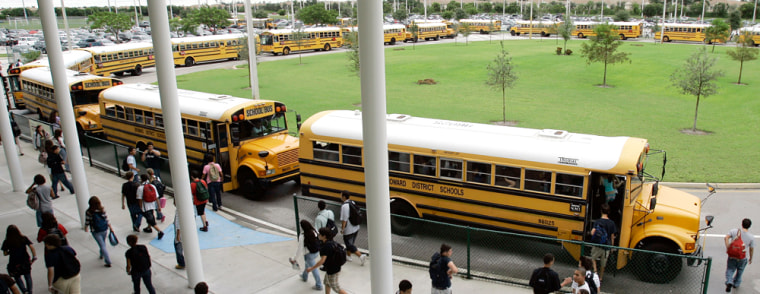The Bush administration on Monday proposed a new rule to improve the safety of school bus seats and expand the use of shoulder belts, but stopped short of ordering that all new buses include seat belts.
Secretary of Transportation Mary Peters rode a packed school bus to Morrisville Elementary School — among the first schools in the country to equip some of its new buses with shoulder straps — then announced a proposed rule that would:
- Increase the height of seat backs on all school buses from 20 inches to 24 inches to help protect older children and adults from being thrown over the seats during accidents.
- Require all new short school buses — the style more prone to rollover accidents than longer buses — to begin using shoulder straps.
- For longer buses, provide federal standards for school districts that make the decision to add shoulder straps and/or lap belts. Districts would also be allowed to use federal highway safety funds to cover the additional cost of equipping buses with those devices.
Districts to decide which buses
Peters promised no new money to cover the costs on seat backs and shoulder straps on shorter buses.
“We want school districts to make that decision,” said Peters, noting that smaller buses don’t carry as many students. “They’ll make the decision about how to protect the most children within their areas.”
A new bus with seat belts costs about $10,000 more than one without them, said Derek Graham, a transportation services official for North Carolina schools. North Carolina puts about 800 new buses on the road each year, meaning the seat belt buses would cost the state an additional $8 million each year.
Schools have increasingly gone to higher seat backs. Peters said that taller children are prone to flying over the seats if the backs are too short.
“It’s like putting an egg in an egg carton,” she told Sarah Omwenga, a 7-year-old who sat next to Peters on her ride to Morrisville school.
They buckled up in the new bus retrofitted with tall seat backs.
When the rules would start
If the proposals are approved, small buses, which already use lap belts, would have to have shoulder belts within three years. School districts would have to begin using the taller seat backs on new buses within one year.
Peters noted that school buses already are the safest form of driving, with a fatality rate that is nearly six times lower than passenger vehicles.
On average, fewer than eight passengers die in school bus crashes every year, the National Highway Traffic Safety Administration said, even though 474,000 school buses carry 25.1 million children more than 4.8 billion miles annually.
The NHTSA, a part of the Transportation Department, will decide whether to adopt the proposal after a 60-day public comment period.
The full proposal and instructions on how to provide comment are online at www.nhtsa.dot.gov/
